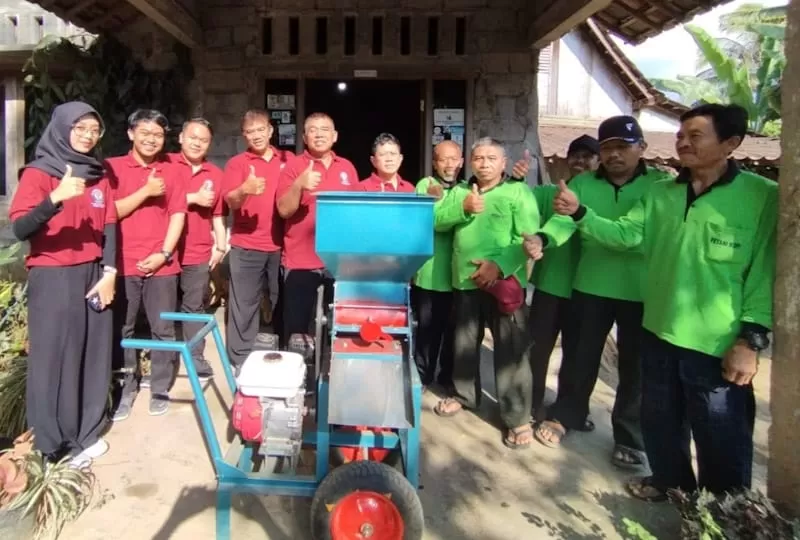Semarang – Coffee is one of the most popular drinks in the world and is consumed in terms of enjoyment and consumer satisfaction. Various innovations continue to be made to increase the efficiency and productivity of the coffee industry.
The latest innovation comes from the Diponegoro University Vocational School Team (SV Undip), who are known as post-millennial innovators from the Lecturers of the Mechanical Design Engineering Study Program (RPM) and the Industrial Chemical Engineering Technology Study Program (TRKI) Undip Vocational School and led by Drs. Sutrisno, MT, this team has succeeded in developing energy-saving coffee roasting technology.
The Undip Vocational School Team funded through the 2024-2025 Diksi “Matching Fund” Program is a downstream activity with Technology Readiness Level (TKT) 9. The team consisting of Hermawan Dwi Ariyanto, S.T., M.Sc., Ph.D, Dr. Riana Sitawati, CA, CPA, CMA, CSRA, Didik Ariwibowo, S.T., M.T, and Mohamad Endy Julianto, ST, MT., assisted by MBKM students have collaborated with industrial partner CV Anugrah Agung Semarang.
Sutrisno, his nickname, said that referring to IPR No EC00202049897 with the invention “Robusta Coffee Roasting Procedure Manual” has the potential for the production of coffee roasting tools, commercialization, and very prospective market opportunities. However, the coffee roasting innovation that has been developed in the coffee industry is still limited to the Gunung Kelir Ungaran coffee KUB. In fact, from a technological perspective, the resulting coffee roasting invention can reduce energy by up to 20% compared to commercial coffee roasting on the market.
However, regarding this coffee roasting innovation, there are still obstacles that need to be overcome, especially in improving the quality of the roasted product which is influenced by the Maillard reaction. Therefore, the development of agitation technology and roasting geometry is crucial to utilizing energy-saving, efficient, and classy roasting equipment such as the Voca-roaster as a commercial product in the industry.
“Conventional roasters currently on the market still use LPG burners with a capacity of 450 gr/hour resulting in high thermal energy consumption for dark roast, reaching 10.5 MJ/kg of coffee or the equivalent of 3 kWh thermal/kg of coffee, at a cost of around Rp. . 1,500,- per kg of coffee. Through the use of downstream Voca-roasters, it is estimated that the efficiency of the commercial-scale roasting process can be increased by reducing thermal energy consumption to 0.5 kWh thermal/kg coffee, as explained by Sutrisno.
“Voca-roaster is a roaster where the heat of the flame is mixed with recirculated air in the combustion chamber which is supplied to the drum, so that the temperature drop in the flame is relatively low. The drum wall is designed to consist of two parts, namely the lower drum and the upper drum. “The lower drum surface is directly connected to the combustion chamber, while the upper drum surface is isolated using a heat insulator,” added Sutrisno.
Sutrisno is the owner of more than 20 patents and IPR explains that heat from the bottom of the drum propagates through the drum walls enters the inner chamber of the drum and heats the inner chamber of the drum. The surface heat in the drum and the heat space inside the drum will provide natural conduction and convection heat transfer modes. This heat will be absorbed by the coffee beans in the drum. To ensure that heat from the coffee beans is distributed evenly, a special stirrer is designed in the drum chamber, so that the thermal energy consumption for the Voca-roaster is targeted at 2.5 kWh thermal/kg of coffee.
Apart from saving roasting energy, the development of Voca-roaster is also able to reduce the occurrence of Maillard reactions which cause the quality of coffee beans to decrease. This is because when the coffee beans start to turn brown during the yellowing process, there is a mixing of carbon dioxide gas (CO2) and water which diffuses simultaneously in the coffee beans, explained Sutrisno.
Sutrisno also explained that when the diffusion pressure for these two compounds is high, the coffee beans will start to open, and at that time the coffee beans will experience cracking or breaking. This phenomenon can be recognized by the crunchy sound of cracking nuts. Through agitation technology and roasting geometry, it will enhance the distinctive taste characteristics of the growing coffee beans. After the first breaking phase, a caramelization process occurs which gives a taste like molasses and caramel.
The benefits and socio-economic impacts resulting from this innovative product include encouraging the implementation of national self-reliance and food sovereignty programs, especially the production of energy-saving, efficient, and high-quality roasting machines, mastery of agitation technology, and roasting geometry, which is a promising investment attraction for industrial equipment providers. Coffee to commercialize the Voca roasting machine, the innovation of mass production of the Voca roaster machine will open up new job opportunities and boost national quality coffee production, said Sutrisno.
Other benefits include increasing competitiveness by utilizing local raw materials and manufacturing which produces products with 100% Domestic Component Level (TKDN), the availability of reliable and efficient technology for the production of Voca roaster machines so that the empowerment of coffee plantations will develop in the field of coffee cultivation. “The implementation of this activity is expected to form a collaborative network between researchers, practitioners, and industry from various fields of expertise and competence with the support of existing resources,” concluded Sutrisno.

